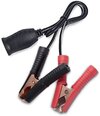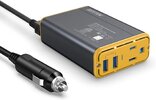carcharger
New Member
What is the simplest, portable, lightest, smallest (even if not the safest or efficient) solution to charge a 2nd car battery (located in the trunk or passenger cabin) while driving a rental car (sedan or SUV)?
For example, can I just use a 3 m jump cable between the two batteries all day/while driving and disconnect this cable from the 2nd battery at night when I am charging the gizmos from the 2nd battery?
Notes:
It must work anywhere in the world, and easy to set up temporarily in a rental car from locally (think Uzbekistan or Zimbabwe) available parts or parts I can take on an airplane from home.
The 2nd battery is the same (so interchangeable, if needed) battery as the build-in car battery. I buy these locally.
Imagine 4 weeks safari or outback drive in a rental, where you do not see an electric wall outlet but need to charge your laptop, cameras, phones, etc. both during the day/drive (that's easy) and night. The 2nd battery is for night charge, so I am not risking a dead battery in the morning.
The 2nd battery is connected to (I am open for better suggestions):
BESTEK 12V 24V Extension Cord Plug Socket with Battery Clamp, then
BESTEK 150W Power Inverter DC 12V to 110V AC Converter.
For example, can I just use a 3 m jump cable between the two batteries all day/while driving and disconnect this cable from the 2nd battery at night when I am charging the gizmos from the 2nd battery?
Notes:
It must work anywhere in the world, and easy to set up temporarily in a rental car from locally (think Uzbekistan or Zimbabwe) available parts or parts I can take on an airplane from home.
The 2nd battery is the same (so interchangeable, if needed) battery as the build-in car battery. I buy these locally.
Imagine 4 weeks safari or outback drive in a rental, where you do not see an electric wall outlet but need to charge your laptop, cameras, phones, etc. both during the day/drive (that's easy) and night. The 2nd battery is for night charge, so I am not risking a dead battery in the morning.
The 2nd battery is connected to (I am open for better suggestions):
BESTEK 12V 24V Extension Cord Plug Socket with Battery Clamp, then
BESTEK 150W Power Inverter DC 12V to 110V AC Converter.
Attachments
Last edited:



